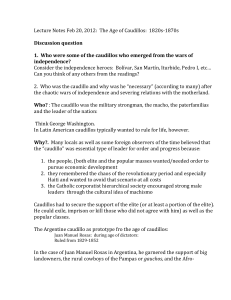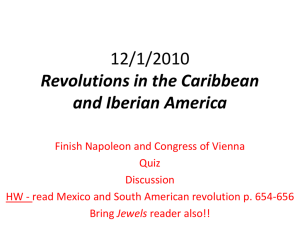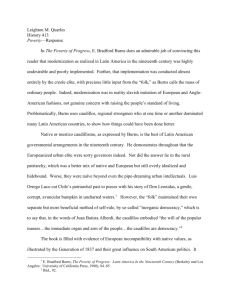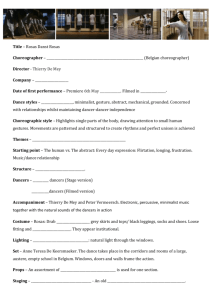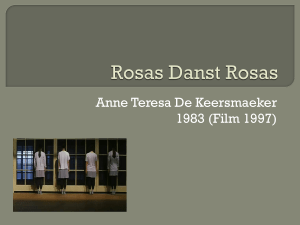Rule of Caudillos by LA country
advertisement
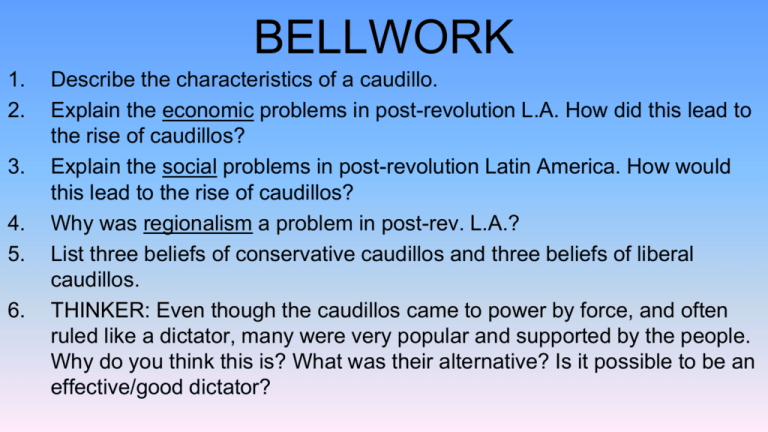
BELLWORK 1. 2. 3. 4. 5. 6. Describe the characteristics of a caudillo. Explain the economic problems in post-revolution L.A. How did this lead to the rise of caudillos? Explain the social problems in post-revolution Latin America. How would this lead to the rise of caudillos? Why was regionalism a problem in post-rev. L.A.? List three beliefs of conservative caudillos and three beliefs of liberal caudillos. THINKER: Even though the caudillos came to power by force, and often ruled like a dictator, many were very popular and supported by the people. Why do you think this is? What was their alternative? Is it possible to be an effective/good dictator? Caudillo Presentations • Brainstorm a list of things you could do to improve your presentation from the last project. • Project is worth 80 points and you will be graded individually using this rubric…… • Since you will be learning about a lot of people, it is imperative you understand the rule of that caudillo; therefore, the group will present,, then they will ask the closure questions, then we will discuss. • You will complete the graphic organizer during presentations. • Make your notes summarized! Look for common themes! • KEEP IT SIMPLE! Caudillo Presentations 1. 2. 3. 4. 5. 6. Rosas (Argentina) Artigas (Uruguay) Carrera (Guatemala) Paez (Venezuela) Castilla (Peru) Santa Anna (Mexico) BELLWORK 11/20 1. In six words or less, explain how the revolutions in Latin America led to the rise of caudillos. 2. Explain the problems Argentina suffered postIndependence. 3. What is an estanciero? Why did the estanciero class support Rosas? 4. Describe how Rosas came to power. 5. Explain two policies/laws/etc. implemented by Rosas. 6. How did Rosas fall from power? What changes were made in Argentina post-Rosas? Argentina: Problems post-Revolution • Political divisions – Federales: Federalists, conservative, regionalists (Rosas) – Unitarios: Unitarians, liberal, centralized government (Rivadavia) • Territorial divisions – Buenos Aires: Spanish trade monopoly, key port city, free-trade zone dominated by local government, wealthy, federalist – Interior provinces: Suffered from European competition (wine/textiles), no political power, unstable, no access to BA ports, unitarian • Economic divisions – Power of estanciero class: owned estancias – large estates used for farming, worked on by lower classes (Latin American estate owners) Argentina: Rule of Rivadavia • • • • • • Goal: unify Argentina under a strong central government that promoted • economic development of the whole territory Education, social, economic reform Balanced development of industry and agriculture Land distribution New Constitution in 1825 – proposed unification with BA and allowed full access to ports….rejected! Although he made several beneficial changes to society, why was he still unpopular, and eventually resigned? Federalist caudillos of Buenos Aires, feared that the rise of a strong national government would mean the end of their power EXILED!!! Argentina: Rise of Rosas POWER TO BUENOS AIRES!!! • • • • Describe how Rosas came to power. Governor of Buenos Aires in 1829 Supported by estancieros Federalist!!! Believed Buenos Aires should stay separate, but represent other provinces in foreign affairs (provinces could control own domestic affairs) • Buenos Aires retained revenue for its exclusive use and controlled trade and river system • A network of personal alliances, backed by force, allowed him to come to power Argentina: Rule of Rosas • • • • • • Explain two policies/laws/etc. implemented by Rosas. For Rosas, and the ruling class of estancieros, the only economic concern was the export of hides and meat, and import of foreign goods Conquest of indigenous land = sell for profit! Fear of the masses: used gauchos and private army to control them – Colonial punishments: torture, whipping Rule based on informal alliance of estancieros, militia commanders, & secret police (Mazorca) – Terrorist organization; murdered opposition Estancieros of Buenos Aires enjoyed massive wealth • “I thought it very important to gain a decisive influence over this class in order to control and direct it” Rosas Fun Facts!!! • • • • Joined the military at 13 In a country where most of the population was illiterate and uneducated, Rosas argued that rigged elections were the only way to reach stability His cabinet was composed of powerless figures, and Rosas noted: "Do not imagine that my Ministers are any thing but my Secretaries. I put them in their offices to listen and report, and nothing more” Modern estimates report around 2,000 people were executed from 1829 until 1852; common methods included throat slitting, castration or scalping • Rosas led a war against the Natives at the same as Jackson; 1830-1833 All official newspapers under Rosas’ rule, carried the slogan: “Death to the savage, filthy Unitarians!” • Rosas’ rule maintained power of creoles and oppressed majority of mixed race, Natives, & blacks • “It may appear unjust to exterminate savages, destroy civilizations, and conquer peoples who occupy land that is rightly theirs, but thanks to this injustice, America, instead of being abandoned to savages who are incapable of progress, is today occupied by the Caucasian race, the most perfect, intelligent, beautiful, and progressive of all the races that inhabit the Earth” – Conservative caudillo & supporter of Rosas, Domingo Sarmiento Argentina: Fall of Rosas • How did Rosas fall from power? • Angry over economic oppression, anti-Rosas forces Adios Rosas! formed a coalition in 1852 Argentina….unite!!! • United farmers, natives, liberals and federalists under Justo Jose de Urquiza (Entre Rios) • Worked together to defeat Rosas’ army • Rosas fled to exile in England Argentina: Post-Rosas • • • • • What changes were made in Argentina post-Rosas? Did not end dispute between Buenos Aires and other provinces or between federalism and Unitarianism. Slower process of economic change will eventually bring unity Union of provinces will all share the wealth of Buenos Aires…..obtain by force! BA refused and two sides agreed to peaceful separation New Constitution in 1853 – – – – – • • • Modeled after U.S. United Provinces became a federal republic President (6 year term) Legislative branch – Senate & House Catholicism is official religion; freedom of worship For five years there were two separate Argentinas: the Argentine Confederation (Urquiza) & Province of Buenos Aires 1859: War between the two 1862: Compromise, unification, capital established at Buenos Aires Today’s Agenda…. • Artigas • Carrera • Review – Similarities/differences between Rosas and Carrera – Similarities/differences between Artigas and Carrera – Similarities/differences between Rosas and Artigas Paraguay Compare/Contrast Paraguay & Uruguay BELLWORK 11/21 1. How did Artigas come to power? How did he fall from power? 2. List two of Artigas’ liberal reforms. 3. Explain the problems in Guatemala post-independence. How did these problems lead to the rise of Carrera? 4. List two of Carrera's conservative reforms. 5. THINKER: In 1855 an anonymous author said: “Independence is only a name. Previously they ruled us from Spain, now from here. It is always the same priest on a different mule.” What does this quote say about society postindependence? How does it relate to rule of the caudillos? Uruguay Guatemala & Rafael Carrera Guatemala • Problems post-independence: • 1823 – Republic of Central America: Honduras, Nicaragua, Costa Rica, El Salvador and Guatemala • Gradually states formed their own government, but split between two parties • Liberal – middle class, artisans and merchants • Conservative – old elite, monopolistic, landowners, church • Civil War = Liberal Morazán becomes president (unpopular with conservatives) Rafael Carrera - Overview • • • • • Grew up in a barrio of Guatemala City under Spanish colonial control He was a mestizo and illiterate. Worked on a farm before joining military Many conservative caudillos were interested in power for their own gain. Carrera was an exception & represented the interests of Guatemala's Indian majority Backed by the Church, conservatives, and land owners, he dominated politics in the first five decades of Guatemala's independence (actually in power 1842-1865) led the revolt against the federal government and was instrumental in breaking up the United Provinces of Central America Guatemala • During the Civil War, Carrera was the general of conservative troops Rafael Carrera did not support Morazán's liberal policies Morazán repeatedly chased Carrera's forces out of cities and towns, but Carrera's followers would retake places as soon as Morazán's army left • A cholera epidemic added to the frustration and helped Carrera rally the peasants into a military resistance against the liberals Morazán Liberal • leader & president of • Guatemala Enemy of Carrera Guatemala • He mobilized an army and took Guatemala City. • Supported Catholic rule and death to foreigners. • Ended Federal Republic and established a conservative regime. • Made Congress name him “President for Life!” Guatemala • Revived authority of the church • Brought back native forced labor and colonial titles • What began as a lower class protest against modernization, soon changed into a conservative government controlled by a merchant oligarchy • The wealthy elite provided him with money needed for his army • Determined to dominate Central America • After he died in 1865, the violencefilled period ended and liberalism was restored Today’s Agenda…. • Paez (Venezuela) • Castilla (Peru) • Discuss: similarities differences BELLWORK: Block 1 1. 2. 3. 4. 5. 6. Which caudillos were liberal? Which were conservative? Which caudillos were supported by oligarchies? Describe the rise/rule of Jose Paez. Describe the rise/rule of Ramon Castilla. In your opinion, who was the most successful caudillo? Why? THINKER: As you know, many caudillos served multiple terms non-consecutively. Why do you think this is? Why was it difficult for these caudillos to maintain control? Venezuela • Problems post-Independence: • Conflicts over slavery – Many felt it was necessary • Bolivar changed rights of creoles and natives, but was criticized by wealthy elite and military caudillos Venezuela - Paez • • • • • • • • Jose Antonio Paez was elected in 1830 from the conservative side (some view as moderate) Was a military hero and champion of Venezuelan independence Combined presidency with general of supreme army Terrified of slave revolts and uprisings = race war! Arrested Liberal leader, Guzman, and sentenced him to death New Constitution in 1830 limited suffrage to 21 year old literate & wealthy males. Was president three different times: 1830–1835; 1839–1843; 1861–1863 Returned to rule whenever the national government failed Venezuela - Paez • • • • • • • Allied with the conservative oligarchy because the oligarchy controlled a great amount of their country's wealth but was not popular with the masses whereas Páez was very much liked by the masses Ended dominance & economic power of the church conflict between church and state ceased to exist unlike other countries in Latin America In 1847 President Jose Tadeo Monagas, who was put into power by Páez, dispersed Congress and proclaimed himself dictator. Páez led a rebellion against him but was defeated and eventually exiled. (1850) In 1861, he became supreme dictator and ruled only for two years before again returning to exile. He lived in New York during his years in exile and died there in 1873. Peru • Problems post-independence: • Bolivar attempted to end slavery and equalize power; considered everyone Peruvian citizens. • When he left in 1826, the Creole government reinstated taxes on indigenous population and slaves (government depended on this revenue) • Revolution ruined mines and plantation agriculture; could not compete with foreign powers • Massive trade debt with England • Elite landowners were angry at social revolts and instability • Absence of governing class and political instability led to civil wars Peru • Under these conditions, people demanded change! • Led to the rise of the military general and mestizo, Ramon Castilla (president from 18451851 & 1855-1862) • • • • • • • Peru Emphasis on guano exports (England) Guano boom led to the creation of railways Social reforms – abolished slavery & indigenous tribute Slave owners received 40% of slave value Freed blacks became farmers = increase in cotton, sugar, and grain Modernization in costal agriculture: use of cotton gins, boilers, refinery equipment, and steam-drive tractors. After Castilla’s presidential term was over, Peruvian farmers depleted guano deposits and Peru went into a period of debt. Agenda • Today: • Antonio Lopez de Santa Anna (Mexico) • Caudillo Review • Homework: MexicanAmerican War Wkst and Reading • Tomorrow: • Mexican-American War Lesson & Discussion Mexico • • • • • • • • Economic Problems Exports did not keep up with imports = trade deficit (began exporting metals; like gold & silver) New government inherited a bankrupt treasury Foreign loans proved ineffective; raised debt to 54 million pesos Britain invested in mining In 1830, government provided assistance to industry, but shortages of capital, lack of consistent policies, and unstable socioeconomic structure halted growth. Had to rely on mining and agriculture Principal exports were silver, tobacco, coffee, vanilla, and henequen (fiber used to make rope) • • • • Political Problems Divisions between liberal and conservative sides: Liberals – power to mestizos and middle class Conservatives – support racial hierarchy; aristocracy Mexico • • • • • • • Led to the rise of Antonio Lopez de Santa Anna (ruled 1834-1854) From the conservative side; did NOT support liberals in power (then, current president Farias) First fought AGAINST Mexican independence from Spain, then for it (military general) Wealthy landowner in port-city of Veracruz He was general or president (or both concurrently) multiple times in his 40-year career. President on eleven non-consecutive occasions over a period of 22 years. Wanted a Catholic, centralist, conservative government (Mexico City) Mexico • He immediately dissolved Congress and began centralizing power (Mexico City!) The regime became a dictatorship backed by the military. • Suspended liberal constitution of 1824 • Increase power of central government; decreased state rights • Land/$ qualifications for power • Restored sales tax and government tobacco monopoly to increase revenue • Mexican-American War led to loss of ½ of Mexico Mexico • Unhappy over economic policies, Alvarez (liberal caudillo) convinced France to send a king to rule = WAR! • 1853 – Santa Anna launched terrorist campaign against dissenters Mexico • After Texan independence Santa Anna wrote a letter to U.S. Minister to Mexico, Joel Poinsett, in which he proclaimed: • “It is very true that I once threw up my cap for liberty with great ardor, and perfect sincerity, but very soon found the folly of it. A hundred years to come my people will not be fit for liberty. They do not know what it is, unenlightened as they are, and under the influence of a Catholic clergy, a dictatorship is the proper government for them, but there is no reason why it should not be a wise and virtuous one” Santa Anna FUN FACTS! • • • • • • • • • Parents were very wealthy; pressured him to pursue a career in commerce During the Mexican Revolution, he was shot with an arrow in the left arm Gambling addict his entire life His habit was to ally with the wealthy and be on the winning side of any battle – Fought with Spanish; Iturbide promised to make him General so he supported Mexico; planned Iturbide’s overthrow Always focused on self-promotion – Proclaimed himself “the Napoleon of the West,” “The Savior of the Motherland” & “The Most Serene Highness” Santa Anna famously used a prosthetic cork leg; during the Mexican-American War, it was captured and kept by American troops. The cork leg is displayed at the Illinois State Military Museum & the Mexican government has repeatedly asked for its return One month after his wife’s death in 1844, the 50-year-old Santa Anna married 15-year-old María Dolores de Tosta During his time in exile in NYC, he is credited with bringing in the first shipments of chicle, the base of chewing gum. His plan was to use the chicle to replace rubber in carriage tires, which eventually failed. Thomas Adams, the American assigned to aid Santa Anna while he was in the United States, experimented with chicle in an attempt to use it as a substitute for rubber. He bought one ton of the substance from Santa Anna, but his experiments proved unsuccessful. Instead, Adams helped to found the chewing gum industry with a product that he called “Chiclets.” Santa Anna was a passionate fan of the sport of cockfighting. He would invite breeders from all over the world for matches and is known to have spent tens of thousands of dollars on prize roosters. BELLWORK 11/26 • Which two caudillos are the most similar? Why? Explain! • Which two caudillos are the most different? Why? Explain! • THINKER: What are you thankful for? Chile Venezuela • Problems post-Independence: • Conflicts over slavery – Many felt it was necessary • Bolivar changed rights of creoles and natives, but was criticized by wealthy elite and military caudillos Venezuela - Paez • • • • • • • • Jose Antonio Paez was elected in 1830 from the conservative side (some view as moderate) Was a military hero and champion of Venezuelan independence Combined presidency with general of supreme army Terrified of slave revolts and uprisings = race war! Arrested Liberal leader, Guzman, and sentenced him to death New Constitution in 1830 limited suffrage to 21 year old literate & wealthy males. Was president three different times: 1830–1835; 1839–1843; 1861–1863 Returned to rule whenever the national government failed Venezuela - Paez • • • • • • • Allied with the conservative oligarchy because the oligarchy controlled a great amount of their country's wealth but was not popular with the masses whereas Páez was very much liked by the masses Ended dominance & economic power of the church conflict between church and state ceased to exist unlike other countries in Latin America In 1847 President Jose Tadeo Monagas, who was put into power by Páez, dispersed Congress and proclaimed himself dictator. Páez led a rebellion against him but was defeated and eventually exiled. (1850) In 1861, he became supreme dictator and ruled only for two years before again returning to exile. He lived in New York during his years in exile and died there in 1873. Venezuela - Gomez • • • • • • Juan Vicente Gomez was a military general and caudillo from 1908 until his death in 1935. Gómez was a barely literate cattle herder and a nearly full-blooded Native American. In 1899, he joined the private army of Cipriano Castro, with whom he had been friends since Castro's exile in Colombia. This army swept down President Caracas in 1899 and seized control of the country. He became Castro's vice president and, in 1902, head of the military, responsible for suppressing several major revolts against the government. Liberal Gómez seized power from Castro on 19 December 1908, while Castro was in Europe for medical treatment Venezuela - Gomez • Economic troubles (falling coffee prices) led to period of recession • Gómez managed to decrease Venezuela's debt by granting concessions to foreign oil companies • Won him support of the United States • Used the money to launch an extensive public works program • He also received generous kickbacks, increasing his personal fortune enormously • Support did not last long…… foreign powers blockaded Venezuela and demanded payment of debts • • • • • • Venezuela - Gomez Brought enrichment to the country, particularly after the discovery of oil, which enabled the development of a modern infrastructure. His focus on road construction and the creation of jobs promoted social contact among Venezuelans of different regions – previously a rare occurrence – which created a sense of national unity in the country He brought about the end of civil wars by exerting power over regional caudillos and, as a result, Venezuela became a peaceful country and has been so for more than a century During his rule, most of the country's wealth ended up in the hands of Gómez, his henchmen, and Wall Street. At the time of his death, he was by far the richest man in the country. He did little for public education and held basic democratic principles in disdain. Although cordial and simple in manner, his ruthless crushing of opponents through his secret police earned him the reputation of a tyrant. Gomez FUN FACT! • Gómez was never married; however, he had two mistresses. The first one was Dionisia Gómez Bello, with whom he had seven children. The second one was Dolores Amelia Núñez de Cáceres, with whom we had eight children. Gómez also fathered many other children in brief relationships: at least 64 and possibly as many as 84. He appointed many of his children to public office Graffiti Board – Caudillo Review • A graffiti board is a visual representation of a topic. • It can include pictures, statements, quotes, charts, descriptors, words, etc. • A free expression of your knowledge and understanding • Today, each group will re-teach a caudillo to the class using a graffiti board. • Your poster should include the main info about your caudillo, but also any comparisons to other caudillos.
